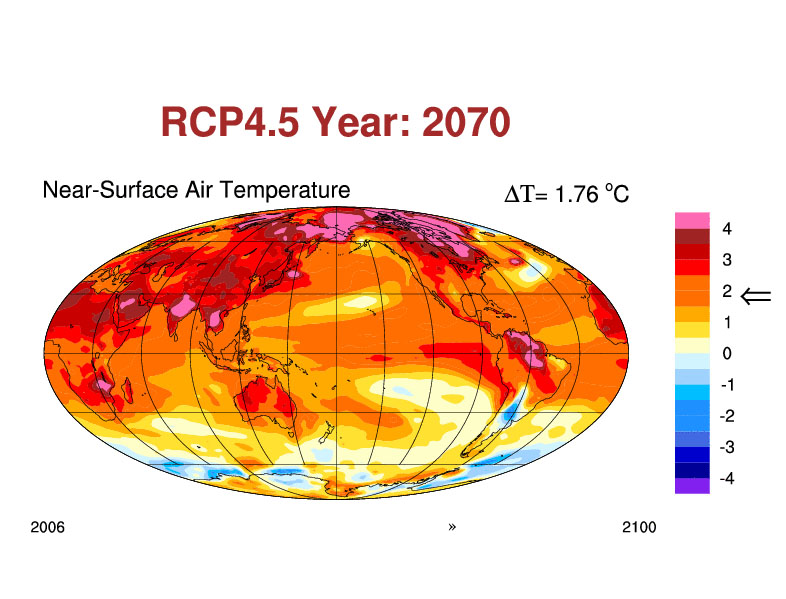We rely a lot on climate models. They not only help us understand our present climate, but also allow us to understand possible future conditions and how different regions of our planet are likely to be impacted by climate change.
Having access to this information is vital for the community, government and industries to make informed decisions – sectors like tourism, farming and transportation to name a few.
As useful as these tools are, the reality is that the Earth’s climate system is incredibly complicated. It is affected by an infinite number of variations in the atmosphere, land surface, oceans, ice, and biosphere. How these factors interact with one another, and our socio-economic decisions, further complicates the issue.

Two icebergs on Jokulsarlon lagoon Iceland
Our climate system is affected by variations in the atmosphere, land surface, oceans, ice and biosphere.
In the absence of a twin Earth to use as an experimental control, simulations are the only method we have to understand the future.
Using observed data, advanced algorithms and software systems, scientists have been developing and refining these valuable climate models for years. However in recent times, there has been conjecture about a key aspect of the reliability of these models; whether they are accurately predicting temperature trends?
A new study, published today in Nature Climate Change, shows that yes in fact, they are.
According to the study’s lead author Dr James Risbey, the key to evaluating decadal climate variations is recognising the difference between climate forecasts and climate projections.
He explains that climate forecasts track the detailed evolution of a range of factors, including natural variations like El Niño and La Niña (which put simply is, warm water sloshing around the ocean). This is important because in El Niño and La Niña dominated periods, temperature trends will naturally speed up and slow down.

climate model
A visualisation of temperature projections for a mid-level greenhouse gas emission scenario (ACCESS)
“Climate projections, on the other hand, capture natural variations, but have no information on their sequence and timing. Since these can impact the climate on a short timescale as much as human activities, their omission from projections creates a mismatch with observed trends. In other words, comparing the two wouldn’t pass the old ‘apples with apples’ test,” he said.
For this latest study, James and his colleagues looked at a range of different climate models that were in phase with natural variability. In doing so, they were able to make meaningful comparisons between model projections and observed trends.
Their analysis showed that in these instances climate models have been very accurate in predicting trends in our climate over the past half century. In other words, climate change models are a lot more than hot air.
Fine out more about our research into climate in our recent report State of the Climate: 2014.
Media Contact: Simon Torok +61 409 844 302 or simon.torok@csiro.au


5th August 2014 at 7:26 pm
While I’m sure that “climate forecasts track the detailed evolution of a range of factors” perhaps Dr James Risbey can explain what errors in the BOM’s models have caused their spectacular failure to predict (or even be decisive about), whether we will have an El Niño this year.
I would suggest that the accurate prediction of the El Niño Southern Oscillation is of more importance to Australian farmers than your “CSIRO releases Spanish version of free pesticide risk tool” or perhaps a “3D printed shoe CSIRO built for a race horse”, the CSIRO should withdrawn monies (remember the budget people!) and instead help BOM with their model!
But I digress. Here are (selected) quotes from the BOM’s ENSO Wrap-Up, illustrating that their El Niño model(s) is about as useful as an ashtray on a motorbike – for predictions longer than one month.
8 April 2014
It is now likely (estimated at a greater than 70% chance) that an El Niño event will
develop during the southern hemisphere winter.
6 May 2014
Climate models surveyed by the Bureau suggest El Niño development is possible as early as July. These factors indicate that while El Niño in 2014 cannot be guaranteed, the likelihood of an event developing remains at least 70% and we are at El Niño ALERT level.
20 May 2014
The tropical Pacific Ocean continues a general trend toward El Niño, with just over half of
the climate models surveyed by the Bureau suggesting El Niño thresholds will be exceeded
by August. An El Niño ALERT remains in place, indicating at least a 70% chance of an
El Niño developing in 2014.
3 June 2014
The tropical Pacific Ocean remains on track for El Niño in 2014, with just over half of the
climate models surveyed by the Bureau suggesting El Niño will become established by
August. An El Niño ALERT remains in place, indicating at least a 70% chance of an El Niño
developing in 2014.
1 July 2014
Climate models surveyed by the Bureau continue to indicate that El Niño is likely to develop
by spring 2014. The Bureau’s ENSO Tracker remains at El Niño ALERT, indicating at least a
70% chance of El Niño developing in 2014.
15 July 2014
While the majority of climate models suggest El Niño remains likely for the spring of 2014,
most have eased their predicted strength. If an El Niño were to occur, it is increasingly
unlikely to be a strong event.
29 July 2014
Given the current observations and the climate model outlooks, the Bureau’s ENSO Tracker
has shifted to El Niño WATCH status. This means the chance of El Niño developing in 2014
is approximately 50%, which remains significant at double the normal likelihood of an event.
5th September 2014 at 8:55 am
When will CSIRO and other researchers ever accept that climate change is controlled by Mother Nature. Human input is so small that it really does not matter.
22nd July 2014 at 11:29 am
Reblogged this on The Kettle Press and commented:
There is no planet B.
Climate change is not just all hot air.
21st July 2014 at 3:33 pm
Your concern for the environment appears to be in conflict with your association with the coal industry in spending large amounts of money (and/ or) lending your imprimatur in trying to find ways of converting coal to liquid fuel, “clean coal” and being linked to the “Obeid” scandal as discussed on ABC’s Background briefing last Sunday in which I think I heard that CSIRO refused to be interviewed. Is this true?
21st July 2014 at 4:42 pm
Not true. Our spokeperson was actually interviewed on that program at length. You can listen to the podcast on the ABC’s website:
http://www.abc.net.au/radionational/programs/backgroundbriefing/mr-clean-coal/5601074#transcript
22nd July 2014 at 11:51 am
My apologies, on replaying the broadcast, what I heard was that CSIRO declined to discuss with Mr.Pickering, the general use of coal as a fuel source. What also disturbs me is that CSIRO has worked with Mr. Duncan who was criticised by ICAC. May I suggest you find time to listen to the broadcast, especially the last 12 minutes. It disturbs me that CSIRO has changed from a completely independent research body to one immersed in the commercial fields of research. Developing the DICE engine is ludicrous. Research into photo voltaic generation is far more important and advantageous to the planet, but where will the money to do it come from?